

Canon EOS 5D vs. Canon EOS 40D
With Canon's "instant rebates" on the EOS 5D and EOS 40D, many photographers are considering upgrading to one or the other. The 5D is about twice the cost of the 40D, so it's an obvious question whether the 5D or 40D is the "better" upgrade path. The answer isn't 100% obvious. First let's look at a few of the more significant technical differences between the two cameras.
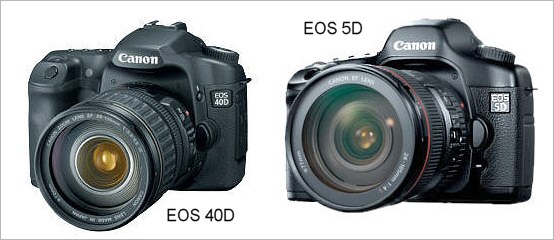
Sensor - This is the "biggie". The 5D has a full frame 24mm x 36mm sensor with 12.7 million pixels, while the 40D has an APS-C, 15mm x 22.5mm CMOS sensor with 10.1 million pixels. The 40D also has a ultrasonic "sensor shaker" to dislodge dust particles, while the 5D doesn't.
Flash - The 40D has a built in flash, the 5D doesn't. The sync speed of the 5D is 1/200s, the sync speed of the 40D is 1/250s. Both have a 250v maximum sync voltage rating.
Continuous Shooting - The EOS 40D is good for 6.5fps, the 5D is good for 3fps. The buffer sizes are similar. The JPEG/RAW buffer size is 75/17 for the EOS 40D and 60/17 for the EOS 5D
A/D conversion - The 5D is 12-bit, the 40D is 14-bit. Theoretically 14 bits are better, though in practice it's very hard to see any difference.
Viewfinder - The EOS 5D viewfinder is significantly larger than that of the EOS 40D.
Live View - The 40D has it, the 5D doesn't. Personally I haven't actaully used the LiveView function on my 40D for anything but testing it, though I know some people do use it more. I don't think I'd miss it much myself.
ISO range - the 5D has 50-3200, the 40D has 100-3200. For prints of a given size, the 5D shows less noise at high ISO settings than the 40D does. An example is shown below with both cameras set to ISO 3200. The difference isn't huge, but it's definitely there. The crops below are adjusted to represent sections of equal size prints from both cameras.

Overall I guess you could say that the EOS 5D is more similar to the EOS 30D the the 40D. You could look at it as a 30D but with a full frame sensor and a few extra features, while the EOS 40D is an upgrade of the 30D. The added features are incremental rather than revolutionary, but there's no doubt that the 40D is more technically advanced than the 5D. However the full frame sensor may more than makes up for the difference in features if image quality is your goal.
"Crop Factor" and EF-S lenses
The fact that the 40D has a smaller sensor means that lenses mounted on a 40D give the same field of view as lenses 1.6 x longer do when mounted on an EOS 5D. So, for example, a 10MM lens on a 40D gives the same view as a 16mm lens on a 5D. There are special lenses designed to cover only the APS-C frame. Canon designates these lenses "EF-S". EF-S series lenses can be mounted on any APS-C sensor fron the EOS 20D and EOS Digital Rebel XT onwards. They will not however mount on any full frame camera such as the EOS 5D or any of the 1Ds (or 1D) series camera bodies. However all lenses will full frame coverage (EF series lenses) will mount on both full frame and APS-C digital bodies (and the 1.3x APS-H 1D series bodies. What this means is that if you buy a 40D and lenses such as the EF-S 10-22 and EF-S 17-85, you won't be able to use those lenses on an EOS 5D. However if you buy a 5D, any lens that you buy for it will also work just fine on an EOS 40D (though with a narrower angle of view). Some people avoid EF-S lenses for this reason, thinking that they will eventually end up with a full frame digital camera.
Wideangles and Fisheye Lenses
Due to the "crop factor", the field of view of any lens mounted on the EOS 40D will be smaller than that of the same lens mounted on the 5D. Of course this isn't an issue if you're buying new lenses, since you can get an EF-S 10-22mm lens for the 40D which gives it about as wide a field of view as you can get with 5D. At 10mm it has the same field of view on the 40D as a 16mm lens does on the 5D. In fact the EF-S 10-22mm on the 40D has the same field of view range as the EF 16-35mm does on the 5D. There is a 14mm prime available which is wider (on a 5D) and there's a Sigma 12-24 which is even wider on the 5D, so if you want the widest possible field of view, the 5D wins out, but only just! If you have wideangle lenses from the days when you used to shoot film, the 5D will allow them their full wideangle potential, whereas the same lenses mounted on a 40D will produce a much narrower field of view.
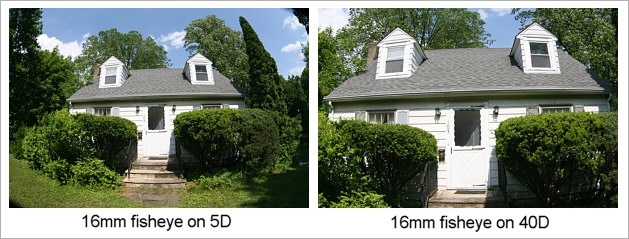
The full frame 5D also allows the use of a 180 degree diagonal fisheye (15/16mm) and a circular fisheye (8mm) to full effect. On a 40D a 16mm fisheye doesn't show a strong fisheye effect and an 8mm lens doesn't provide a full 180 degree circular image.
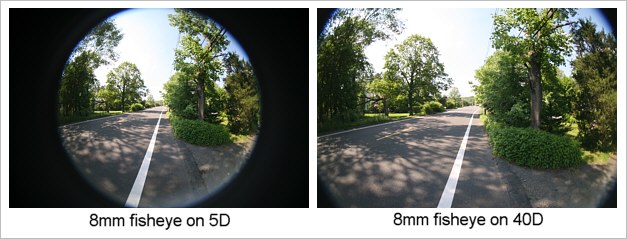
"Normal" Lenses and Zooms
Canon have a big enough range of wide/normal/short-tele primes and zooms that you can pretty much get whatever field of view you need. However some lenses are better on a 5D than an EOS 40D. For example the EF 24-105/4L IS USM is widely regarded as one of Canon's best lenses. It will fit on both the 5D and 40D, but on the 5D it has a very useful range from a true wideangle, though the "normal" focal lengths between 40 and 60mm to the short tele range ideal for portraits (80 to 100mm). On an EOS 40D 24mm is no longer wide, in fact it's equivalent to a 38.5mm lens on a 5D in terms of angle of view. It still covers the normal and short tele ranges, but if you want a wideangle on a 40D, you'll have to switch to another lens. Of course there are such lenses (EF-S 17-55/2.8IS, EF-S 17-85IS, EF-S 18-55IS), but none have quite the range and speed of the 24-105/4L IS. However the 17-55/2.8IS is a pretty nice lens on a 40D. It doesn't have quite as wide a field of view range as the 24-105/4L, but it is a stop faster, However it's an EF-S only lens, so it won't do you much good if and when you upgrade to a full frame DSLR.
Still, in this region it's pretty much a tie between the 5D and 40D if you're buying new lenses. If you have a legacy of lenses from the days of film, the 5D might well be a better match to the set of focal lengths you own.
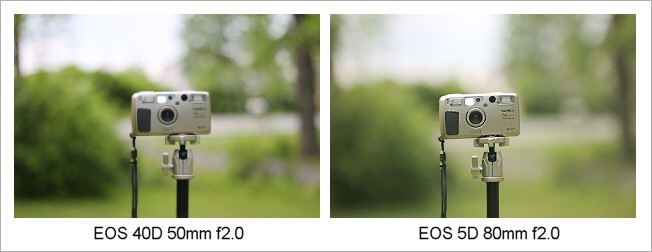
For a given view, the 5D will blur out backgrounds more. For portrait work or any work where you want to isolate the subject, this can be important. An example is shown above. A different lens was used on each camera so as to give the same angle of view. As you can see, the background in the 5D image is significantly more blurred than that in the 40D image, despite both being shot at the same aperture and from the same position. I've covered the whole subject of Digital and Depth of field in this article - http://www.bobatkins.com/photography/technical/digitaldof.html, but you should be warned that things get a little technical in places.
Telephoto Lenses
In the telephoto range, the EOS 40D wins out in any situation where the lens isn't long enough and you need to crop the image from the 5D. When using a telephoto lens you don't usually have the luxury of getting closer to your subject, so it's likely you'd be shooting from the same position with a 5D and 40D. You also often don't have the luxury of switching to a longer lens or zooming out. If you're working with a 500mm lens, it's not likely you'll have a 600mm lens or 800mm lens to switch to. Most photographers can only afford one super-tele lens, never mind carrying more than one.
Since the 40D has a higher pixel density (smaller pixels) than the 5D, the native 40D image has more pixels than a 5D image cropped down to the same size and so has higher resolution. So if you can't "fill the frame" on the 5D and need to crop the image down, you'd be better off shooting with a 40D. The 40D also has a 6.5fps frame rate which is good for sports and wildlife action work, while the 5D tops out at around 3fps.
So in the telephoto region, the 40D has an advantage whenever your lens isn't quite long enough on a 5D.
Resolution and Sharpness
Resolution and sharpness are slightly different concepts. Resolution is a numerical measure related to the smallest detail that can be resolved in an image. Sharpness on the other hand is a perceived quality and includes contributions from resolution, contrast and acutance (edge effects).
When comparing a 5D image against a 40D image there's the issue of exactly what the two shots should be. Should they use the same lens from different distances to give the same field of view? Should they both be shot from the same distance but using lenses of different focal length to get the same field of view?
For this test I chose to use an EF 50/1.8 lens on both cameras, changing the lens/target distance to get the same field of view in each case. By using this technique, the sharpness of the lens drops out of the equation since it's the same lens at the same aperture. The slight change in focal distance should have no effect on the lens resolution. I used the target which I described in my article on lens testing. Crops from the images are shown below:
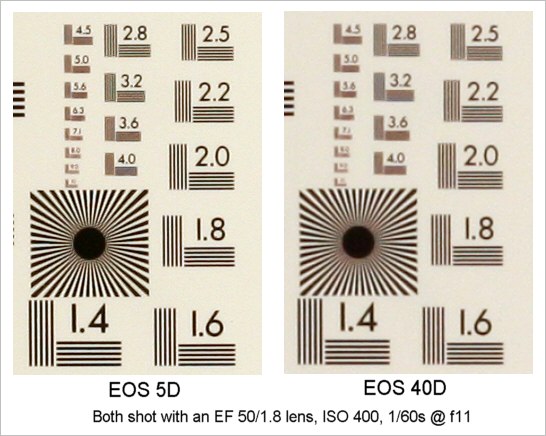
The full images are different sizes of course, but they have been rescaled to appear the same size to simulate the effect of making the same size print from each original image file. On a typical monitor setup, these crops would represent small sections from something like a 20" x 30" print, which is as large as most photographers are likely to make. These are JPEG images straight out of the cameras, with both cameras set to their default settings. It is possible that optimally converted RAW images might show a touch higher resolution, but their relative sharpness shouldn't change significantly. Below is a closer look at the Siemens star pattern.
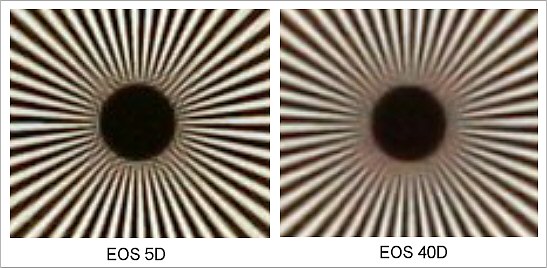
It's pretty clear that the EOS 5D delivers the higher resolution, sharper image. Contrast is s little higher and it's quite clear that the 5D image resolves line sets that the 40D image does not. Just compare the "2.8" test pattern in each image. The Siemens star is resolved all the way in to the center in the 5D image, whereas in the 40D image the lines blur towards the center.
The reason for increased sharpness and resolution is twofold. First there are more pixels, though that doesn't account for all the difference. Second, because it's bigger, for a given image view, the sensor is sampling at a slightly lower spatial frequency at the sensor and thus it's seeing a higher MTF from the lens. To put it a less technical way, the lens doesn't have to "work as hard" when it's being used with the larger sensor. The effect is images with more "snap" due to increased resolution and microcontrast.
I've tested a fairly large number of cameras and lenses using the same test target and setup and the 5D images are the sharpest and cleanest I've yet seen. I have not looked at the 1Ds MkII or III though. I'd expect them to be even better, though at a much higher cost.
Conclusion
If image quality is your ultimate goal, then the 5D is the obvious winner here. Given the appropriate set of lenses, the 5D will generate higher resolution, higher sharpness images which are capable of a greater degree of enlargement. It also enables you to fully utilize specialty lenses like full frame and circular fisheye lenses and get true wideangle coverage from any existing wideangle lenses previously used with film.
If you're a sports and wildlife photographer who regularly uses telephoto lenses and who never seems to have a lens that's quite long enough, then the 40D might be a better match. The 1.6x "crop factor" or "multiplier" of the APS-C sensor may actually be an advantage for telephoto use. Wideangle lenses (such as the EF-S 10-22) are available, as long as you don't mind buying lenses that won't be usable on a full frame camera like the 5D (should you ever buy one) because of their smaller image circle and reduced frame coverage.
Both the 5D at $1900 and 40D at $950 are excellent value right now due to the Canon "instant rebate" program which runs though mid-July. The 5D + 24-105/4L IS USM kit for $2600 is even better value than the camera alone. The 40D + 28-135/3.5-5.6IS USM is also good value at $1150 as long as you realize that 28mm on an APS-C camera is s normal, not a wideangle, focal length.
If you're also looking for a printer, you can get a rebate of $300 on a PIXMA Pro9000 or $350 on a PIXMA Pro9500 if you also buy an EOS 5D or 40D at the same time. Again, these are excellent deals.
What about the EOS 5D MkII?
Well, it looks probable that there will be an EOS 5D MkII and it's fairly likely that it will be released sometime in the fall. I'd expect it to be more or less an EOS 40D with a full frame sensor, just as the 5D is more or less an EOS 30D with a full frame sensor. I'd anticipate a price around $3000 with availability by perhaps October (the original price on the EOS 5D when it was first introduced was $3299). However I could be wrong and it's possible (though I don't think very likely) that it won't appear until Spring 2009. I'm afraid my crystal ball isn't 100% reliable.
I can tell you that I bought an EOS 5D now (I got mine though Amazon.com). I think the value is good (and even better with the 24-105) and the camera is great. The 5D MkII will may be "better" in terms of technology, but I don't really want to wait, I don't really want to spend what I think it will cost and the 5D does everything I really need it to do.
| EOS 5D | EOS 5D Kit | EOS 40D | EOS 40D Kit |
